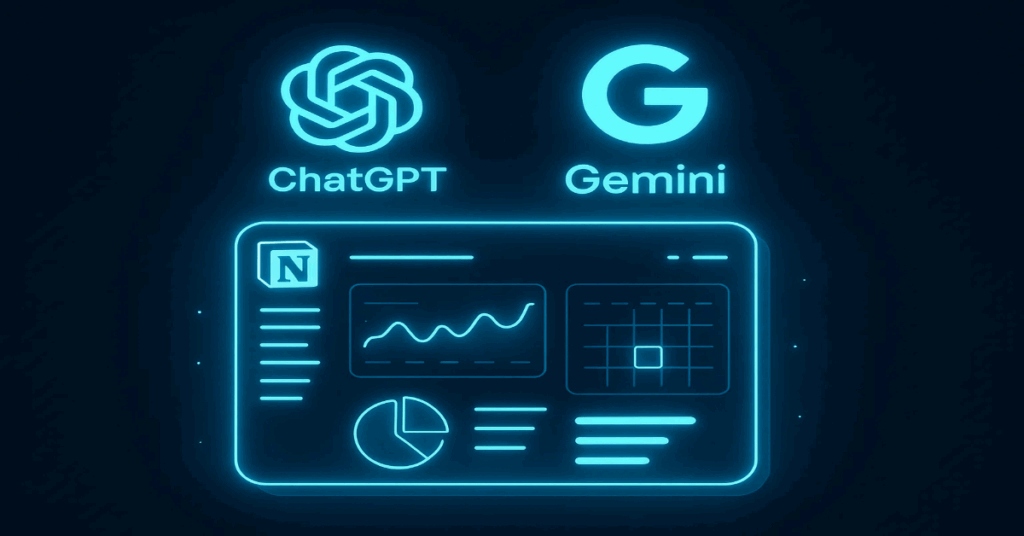ChatGPT Notion Template for Marketers
ChatGPT is no longer just an Artificial Intelligence experiment. For US marketers, it has become the Software they use daily to structure campaign briefs, generate content calendars, and even monitor KPIs. Claude, with its natural Language Model tone, transforms rough drafts into client-ready documents, while Gemini ChatBot validates data and timelines.
Perplexity and DeepSeek remain useful for market research, but when the task is building a practical Notion Template that teams actually use, ChatGPT and Gemini are the duo that delivers.
The Marketing Manager Who Was Drowning in Spreadsheets
Lisa, a marketing manager at a startup in New York, used to manage campaigns across multiple tools: Excel sheets for KPIs, Google Docs for briefs, and random Notion pages for content calendars. Deadlines slipped, data was inconsistent, and her team constantly asked, “Where’s the latest version?”
In frustration, she asked ChatGPT:
Context: Marketing team managing 3 campaigns.
Task: Build a Notion template with:
– Campaign briefs (goals, audience, channels).
– Content calendar (daily posts, owners, deadlines).
– KPI tracker (metric, source, status).
Format: Table structure with headings and sample entries.
ChatGPT generated a working template in seconds. Claude rewrote section labels into clean, professional language. Gemini validated KPI choices and suggested industry benchmarks. Lisa dropped the structure into Notion, and suddenly her team had a single source of truth.
From Chaos to Centralized Marketing Hub
Before, Lisa’s team wasted hours chasing files. After the ChatGPT-built template, everything lived in one workspace:
- Campaign Briefs: One-page outlines with goals, budget, and key messages.
- Content Calendar: Weekly schedules mapped by channel with deadlines attached.
- KPI Dashboard: Automatic status markers (green/yellow/red) validated by Gemini’s suggestions.
The transformation was immediate. Deadlines stopped slipping, and the CEO had a real-time view of campaign performance.
Old vs New Workflow With Notion Template
| Workflow | Old Way | With ChatGPT + Claude + Gemini |
| Campaign briefs | Scattered Google Docs | Centralized in Notion |
| Content calendars | Excel + manual updates | Structured daily schedule |
| KPIs | Manual tracking, inconsistent | Validated dashboard |
| Team alignment | Endless Slack threads | One shared hub |
| Time spent | Hours per week lost | Minutes with AI structure |
The Freelancer Who Turned Templates Into Products
Mark, a freelance marketer in Austin, realized he could reuse the same ChatGPT-generated Notion template for multiple clients.
Context: Client wants a campaign plan.
Task: Build Notion template with:
– Campaign overview.
– 4-week content calendar.
– KPI tracker with metrics (CTR, CAC, ROAS).
Output: Table format with fields ready to copy into Notion.
Claude polished language so it looked professional. Gemini validated CAC and ROAS benchmarks. Mark sold the template as part of his service package — and earned more without extra hours.
The Agency That Built Investor-Ready Reports
At a mid-size agency in Miami, the team used ChatGPT + Gemini prompts not only for campaign planning but also for KPI reporting. Their favorite line:
Summarize campaign performance:
– Top 3 performing channels.
– CAC vs target.
– 2 optimizations for next week.
Output: Table with metric, status, recommendation.
ChatGPT drafted the structure. Claude rephrased in client-facing tone. Gemini validated numbers against DeepSeek datasets. Reports that once consumed Fridays were ready in 30 minutes.
Chatronix: The Multi-Model Shortcut
By month two, Lisa and Mark both faced the same friction: juggling ChatGPT for structure, Claude for tone, Gemini for validation. Copy-paste slowed the very system AI had sped up.
That’s when they tried Chatronix.
Inside one workspace, they had:
- 6 models in one chat: ChatGPT, Claude, Gemini, Grok, Perplexity AI, DeepSeek.
- 10 free queries to test workflows.
- Turbo mode with One Perfect Answer — merging six outputs into one polished draft.
- Side-by-side comparisons to instantly pick the best version.
And since August, there’s been a perk:
The Back2School campaign dropped the first month Pro plan to $12.5 instead of $25. For most agencies, that’s cheaper than one stock photo subscription.
Prompt Library Inside Chatronix
Beyond multi-model chat, Chatronix includes a Prompt Library: tested structures for business, education, marketing, copywriting, SMM. Users say it’s the most valuable feature — no wasted time guessing. Instead, they grab a pre-built marketing prompt like “Campaign brief + KPI tracker” and adapt in seconds.
Bonus Prompt for Marketers
Here’s the exact workflow Lisa now runs before every campaign launch:
Context: Preparing a new digital marketing campaign.
Task: Build a Notion template with:
1. Campaign brief (objective, target audience, budget, key message).
2. Content calendar (platform, post, owner, deadline).
3. KPI tracker (CTR, CAC, ROAS, engagement).
Claude: Rewrite into professional, client-facing tone.
Gemini: Validate KPI choices and add benchmark values.
Output:
– Notion-ready tables for briefs, calendars, and KPIs.
– Notes on benchmarks and recommendations.
It produces a reusable structure in under 10 minutes — something entire agencies now rely on.
<blockquote class=”twitter-tweet”><p lang=”en” dir=”ltr”>Steal this chatgpt cheatsheet for free😍<br><br>It’s time to grow with FREE stuff! <a href=”https://t.co/GfcRNryF7u”>pic.twitter.com/GfcRNryF7u</a></p>— Mohini Goyal (@Mohiniuni) <a href=”https://twitter.com/Mohiniuni/status/1960655371275788726?ref_src=twsrc%5Etfw”>August 27, 2025</a></blockquote> <script async src=”https://platform.twitter.com/widgets.js” charset=”utf-8″></script>
Final Thought
For marketers, the biggest pain isn’t creativity — it’s structure.
ChatGPT builds the framework. Claude humanizes the language. Gemini validates the numbers. Chatronix merges them all in one workspace and adds a Prompt Library so no one starts from scratch.
⚡ That’s why US marketers now say AI-built Notion templates aren’t just time-savers — they’re the backbone of campaign planning in 2025. And yes, it actually works.






